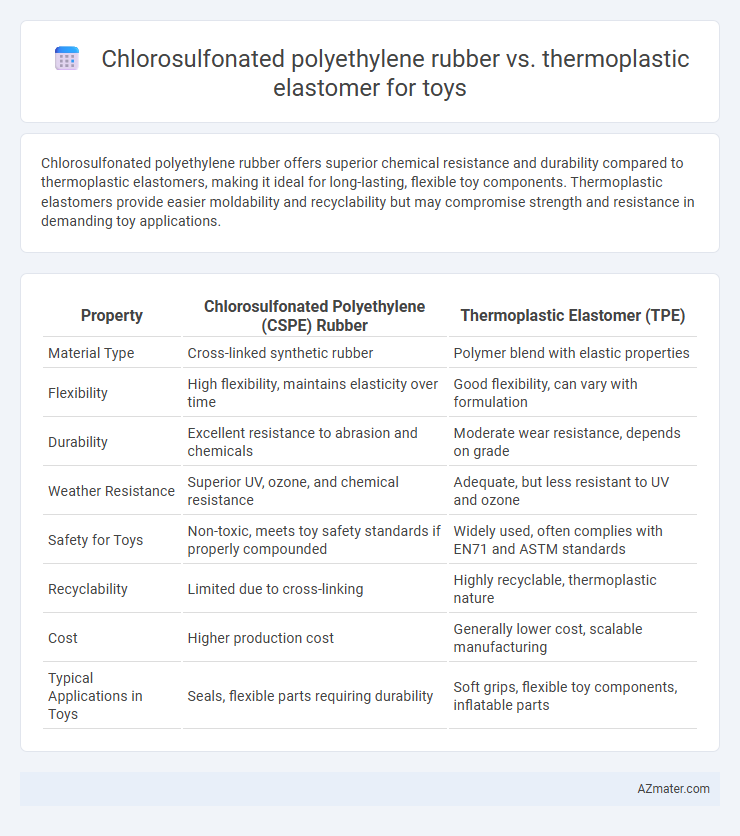Chlorosulfonated polyethylene rubber offers superior chemical resistance and durability compared to thermoplastic elastomers, making it ideal for long-lasting, flexible toy components. Thermoplastic elastomers provide easier moldability and recyclability but may compromise strength and resistance in demanding toy applications.
Table of Comparison
| Property | Chlorosulfonated Polyethylene (CSPE) Rubber | Thermoplastic Elastomer (TPE) |
|---|---|---|
| Material Type | Cross-linked synthetic rubber | Polymer blend with elastic properties |
| Flexibility | High flexibility, maintains elasticity over time | Good flexibility, can vary with formulation |
| Durability | Excellent resistance to abrasion and chemicals | Moderate wear resistance, depends on grade |
| Weather Resistance | Superior UV, ozone, and chemical resistance | Adequate, but less resistant to UV and ozone |
| Safety for Toys | Non-toxic, meets toy safety standards if properly compounded | Widely used, often complies with EN71 and ASTM standards |
| Recyclability | Limited due to cross-linking | Highly recyclable, thermoplastic nature |
| Cost | Higher production cost | Generally lower cost, scalable manufacturing |
| Typical Applications in Toys | Seals, flexible parts requiring durability | Soft grips, flexible toy components, inflatable parts |
Introduction to Toy Material Selection
Chlorosulfonated polyethylene rubber (CSM) offers exceptional chemical resistance, UV stability, and durability, making it ideal for toys requiring long-term outdoor exposure and resilience to wear. Thermoplastic elastomers (TPE) provide flexibility, ease of molding, and recyclability, suitable for toys demanding soft touch and complex shapes with rapid production cycles. Selecting between CSM and TPE hinges on balancing durability with manufacturability and safety compliance for children's products.
Overview of Chlorosulfonated Polyethylene Rubber
Chlorosulfonated polyethylene (CSM) rubber offers excellent chemical resistance, weatherability, and flexibility, making it a preferred material for durable toy components exposed to harsh conditions. Its superior ozone and UV resistance ensure long-lasting performance in outdoor and high-contact play environments. Compared to thermoplastic elastomers, CSM provides enhanced mechanical strength and heat resistance, which extends the lifespan and safety of toys.
Key Properties of Thermoplastic Elastomers
Thermoplastic elastomers (TPEs) exhibit excellent flexibility, high tensile strength, and superior resistance to abrasion and chemicals, making them ideal for toy manufacturing. Their ability to be repeatedly melted and reshaped without losing elasticity ensures efficient recycling and customization, unlike chlorosulfonated polyethylene (CSM) rubber which has limited reprocessing capabilities. TPEs offer enhanced safety due to lower toxin release and better compliance with toy safety standards such as ASTM F963 and EN71.
Safety Considerations for Children’s Toys
Chlorosulfonated polyethylene rubber (CSM) offers excellent chemical resistance and durability but may release hazardous compounds if not properly treated, raising safety concerns for children's toys. Thermoplastic elastomers (TPE) are generally favored in toy manufacturing due to their non-toxic, phthalate-free formulations and compliance with strict safety standards like EN71 and ASTM F963. Prioritizing materials with low chemical emissions and high biocompatibility ensures safer toy products that minimize risks of allergic reactions or toxic exposure in children.
Durability and Longevity Comparison
Chlorosulfonated polyethylene (CSPE) rubber offers superior chemical resistance and UV stability, making it highly durable for toy applications exposed to outdoor elements and harsh conditions. Thermoplastic elastomers (TPE) provide excellent flexibility and ease of processing but generally have lower resistance to abrasion and environmental factors compared to CSPE. For toys requiring prolonged durability and longevity, especially in rugged or outdoor use, CSPE rubber outperforms TPE in maintaining structural integrity over time.
Flexibility and Softness: Playability Factors
Chlorosulfonated polyethylene (CSM) rubber offers excellent flexibility and softness, enhancing toy playability by providing a smooth, pliable texture that resists tearing and deformation. Thermoplastic elastomers (TPE) also deliver high flexibility with superior rebound properties, allowing toys to maintain shape after repeated bending or stretching. While CSM excels in durability under harsh conditions, TPE generally provides a softer, more skin-friendly feel that improves tactile comfort during play.
Manufacturing and Processing Differences
Chlorosulfonated polyethylene (CSM) rubber requires vulcanization during manufacturing, involving heat, pressure, and chemical additives to achieve its final form, whereas thermoplastic elastomers (TPEs) can be processed through injection molding or extrusion without curing, enabling faster cycle times and easier recycling. CSM's chemical resistance and durability make it suitable for toys exposed to harsh environments, but its manufacturing involves longer processing steps compared to TPE's more flexible and cost-effective production. Processing CSM demands precise control of cure times and temperatures, whereas TPEs offer greater adaptability for color and design changes during production, optimizing efficiency in toy manufacturing.
Cost Efficiency for Toy Production
Chlorosulfonated polyethylene (CSM) rubber offers high chemical resistance and durability, making it suitable for toys requiring long-lasting performance but often incurs higher raw material and processing costs compared to thermoplastic elastomers (TPE). Thermoplastic elastomers provide cost efficiency through easier molding, faster cycle times, and recyclability, significantly reducing production expenses in large toy manufacturing runs. Selecting TPE can optimize cost efficiency without compromising flexibility and safety, while CSM rubber is preferable for premium toys demanding superior environmental resistance.
Environmental Impact and Recyclability
Chlorosulfonated polyethylene (CSM) rubber exhibits excellent chemical resistance and durability but poses environmental challenges due to its chlorine content, which complicates recycling processes and may release harmful byproducts during disposal. Thermoplastic elastomers (TPEs) offer superior recyclability and lower environmental impact, as they can be remelted and reprocessed multiple times without significant degradation, making them more sustainable for toy manufacturing. TPEs also reduce pollution and waste generation, aligning with increasing regulatory demands for eco-friendly and non-toxic materials in children's products.
Which Material Suits Toy Applications Best?
Chlorosulfonated polyethylene (CSM) rubber offers superior chemical resistance, weatherability, and durability, making it ideal for outdoor or high-wear toys requiring long-lasting performance. Thermoplastic elastomers (TPE) provide excellent flexibility, ease of molding, and recyclability, which are advantageous for intricate or safety-focused toy designs needing soft touch and rapid production. For toy applications emphasizing safety, flexibility, and cost-effective manufacturing, TPE is often preferred, while CSM rubber is better suited for toys demanding enhanced resistance and longevity.

Infographic: Chlorosulfonated polyethylene rubber vs Thermoplastic elastomer for Toy
 azmater.com
azmater.com